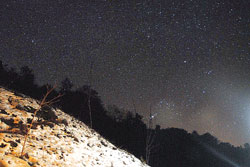|
|
| STARRY NIGHT: Hills near Kathmandu as seen from Nagarkot at midnight, after an unprecedented snowfall two weeks ago. |
In the early morning hours of 4 March, the Full Moon will be eclipsed by the Earth's shadow for about four hours. The event starts at 03:14:52, when the Moon moves into the Earth's shadow (umbra). The Moon will enter completely into the deep darkness of the umbra at 04:28:37 and take more than an hour to pass through this shadow until the northeast part of the Moon begins to emerge at 05:42:49. The time of greatest eclipse will occur at 05:05:44. In Nepal, though, we'll have to watch the Moon set before the show is over.
Exactly half a lunation later, on 19 March, the New Moon will pass in front of the Sun causing a partial solar eclipse from 06:30:34 to 08:17:39. The maximum eclipse will be at 07:22:03, when the Sun will dim slightly and the stars will not come out. A partial eclipse could easily be mistaken as a cloudy moment. This isn't only bad because you will miss out on observing the eclipse, but also because looking straight at a solar eclipse with the naked eye can cause total blindness. Always use special solar filters to watch an eclipse.
The young crescent Moon will be lovely in its position directly above Venus on the evening of 21 March, and when Saturn meets the Moon on 2 March.
Other highlights for March:
The Sun is in the constellation of Aquarius at the start of March, moving into Pisces on 12 March. The Spring Equinox falls on 21 March, when the Sun will cross the celestial equator from south to north at 05:52, making the day equal to the night in the northern hemisphere. This event signals the start of spring in the Northern Hemisphere, and is also called the Spring (or Vernal) Equinox.
Mercury is at its greatest elongation westwards from the Sun on 22 March which means that, in principle, it should be visible in the east before dawn. However, as it comes up just half-an-hour before the Sun, we're unlikely to see this elusive little planet this month.
Venus is a brilliant Evening Star, visible in the west after sunset every day. It doesn't set until three or four hours after sunset, by which time the sky is quite dark. Venus is more likely to be mistaken for an aeroplane, or a UFO.
Mars is still low in the south-eastern sky at dawn, and difficult to see, because it rises only an hour before the Sun.
Jupiter, in Ophiuchus, rises in the south-east about 3AM. By the end of the month, it will be coming up before 01:30 and by dawn almost due south, though still not very high in the sky.
Saturn, in Leo, is the planet best placed for viewing in the evening sky this month, high in the south-east at dusk and setting after sunrise.
The Virginid shower is usually active during March and April, and you may see some meteors they appear to radiate outwards from the constellation of Virgo.



